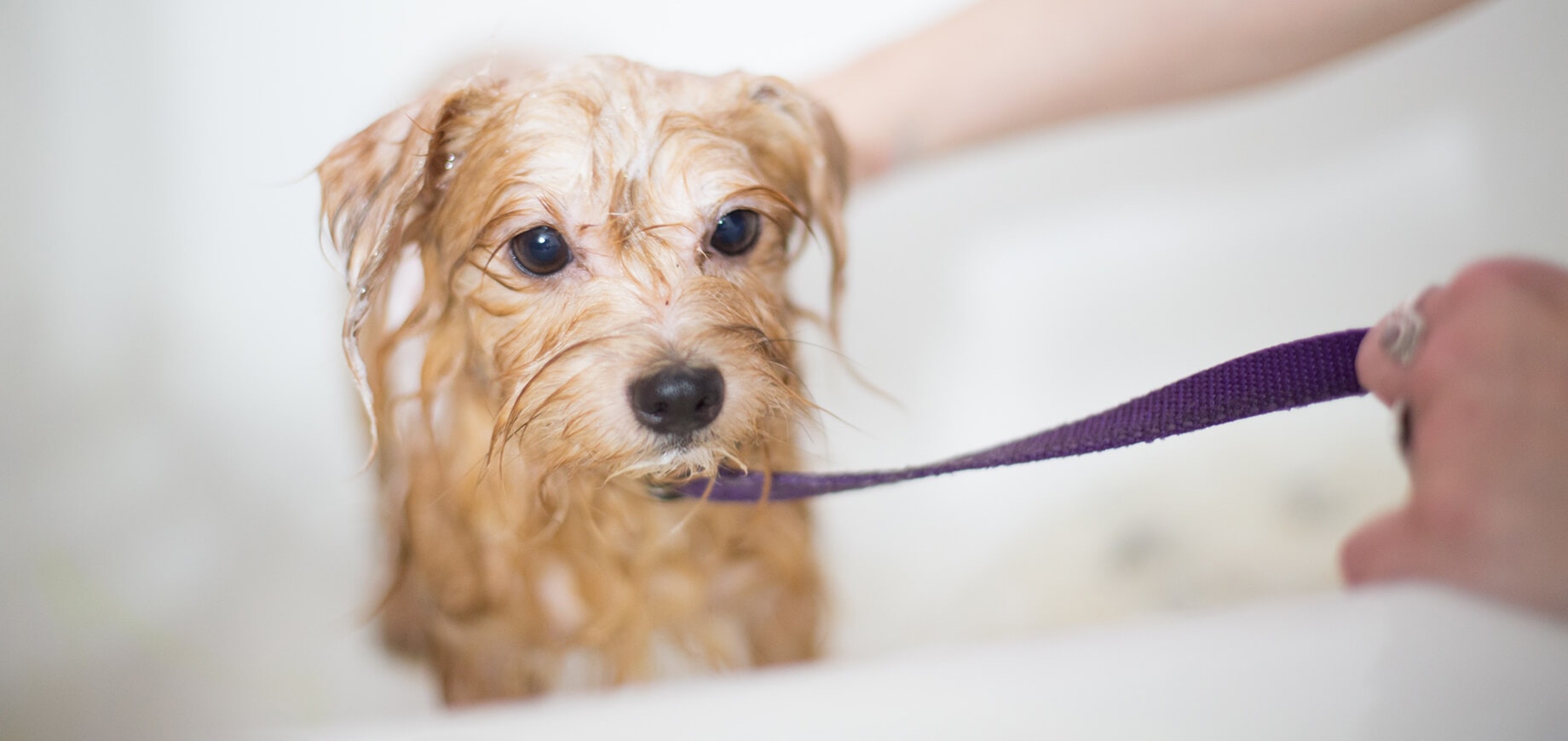

Washing your dog is beneficial as it not only cleans their coat but also removes hair and debris, as well as identifies fleas and ticks which can be more effectively treated when caught early. It also gives you the opportunity to check their skin, to make sure it looks normal and healthy.
Here we delve into how often to wash your dog and the right products to use as well as techniques for successful canine bathing and drying. While dogs can initially protest against a shampooing session, their post-bathing energy burst may not just be because they’re glad it’s over but a sign that they feel better too!
On average a dog should have a wash every 2-3 months, although how often you wash your dog will depend on their coat, lifestyle, the time of the year and whether certain health-related needs, such as skin conditions, are present.
How often you wash your dog will vary by breed and coat type. Short-haired and wiry dogs, such as terriers generally need less washing than long-haired varieties, or those with a thick undercoat, such as a Bernese Mountain Dog. Washing your dog too much or with products that aren’t designed specifically for dogs, can strip away essential oils in their coat and skin as well as breaking down natural defences against bacteria and allergens, meaning they will be itchier and scratch more. The oil in your dog’s fur not only makes it shiny but in breeds such as retrievers, it helps to repel water so they’ll dry quickly after swimming. Oil is essential in producing the individual odour that’s a vital part of the information they share with each other as a greeting. For dogs, smelling sweet is not about roses or lavender but being naturally musky!
Some experts argue that owner’s never really need to wash their dogs unless they actually get themselves dirty. Muddy dogs in Autumn and Winter will obviously mean you're undertaking dog baths more often. Apart from the fact you don’t want mud all over your home, it’s important to wash off all mud after a wet and muddy walk as this could help to prevent Alabama rot disease which is rare but serious.
How much you wash your dog will increase if your dog suffers with certain health-related needs such as skin conditions, allergic reactions or a parasitic infection which can upset the immune system that keeps skin bacteria in check. In many cases, shampoo therapy using a specialist product helps to relieve itchiness by removing allergens from the skin and normalising bacteria again. Other skin conditions actually demand the reverse and you may not be able to wash your dog at all. The best advice here is to have a chat with your vet who’ll be able to recommend the right routine and products for your dog.
How often you wash your dog will depend on recognising some tell-tale signs that they need a good shampoo. Just like when your dog has bad breath and you know it's time for teeth cleaning, the most obvious sign is their smell, beyond the naturally healthy doggy odour of old leather and warm biscuits! A bad smell can be particularly evident if they have rolled in something nasty such as fox poo! Rubbing their back on the carpet may also be a sign that bath-time is imminent but even then, do remember that in the wild, dogs do not wash at all! Other times that you may feel like your dog is due a wash is after they’ve been around other animals, such as a stay in a kennel or if their coat has recently changed.
Human shampoo (especially those containing fragrances and other additives) is not recommended for washing your dog as it is made to suit the more acidic PH balance of our skin and may irritate them, leaving the top layer of their skin sore and flaky. This top layer of skin, known as the ‘acid mantle’, also protects dogs from parasites and bacteria. Damaging it with human shampoo means they’ll be constantly scratching, causing abrasions to form and an infection to develop. While these words of caution are important, using a mild baby shampoo or an unfragranced one with a neutral PH value as a one off when you’ve run out of the canine variety, shouldn’t do any real harm to your dog.
If how often you wash your dog is less than you’d like because they find it stressful then there are a few tips that should help.
It’s important that bath time has positive associations for your dog so do treat them when they follow commands or as a reward afterward. The PEDIGREE® TASTY MINIS range are low in fat and contain Omega 3, Vitamin E and calcium. There are three great flavours: Beef & Cheese, Beef & Poultry and Chicken & Duck.
Dog owners know that the most challenging part of washing a dog is post bath-time when wet hounds want to shake themselves all over the house or rub their bodies on the carpet! Although no method is foolproof, you can prepare for drying them off beforehand using these suggestions.
Unless it’s been recommended by your vet with a specific shampoo, you should not wash your dog once a week as it will reduce the natural oils in their skin and fur as well as their defences against bacteria and allergens. Your dog may have flaky skin and be itchier if you wash your dog more than every 8-12 weeks.
While dogs often seem full of joy after a bath, it can sometimes disorient their sense of smell as they’re ‘too clean’. Dogs navigate the world by scent so may want to roll around in the dirt after a bath, preferring the smell of old leaves to shampoo!
Now you know how often to wash your dog and make bath time enjoyable, why not find out how to brush your dog’s teeth to ensure your dog has the best dental hygiene too!

